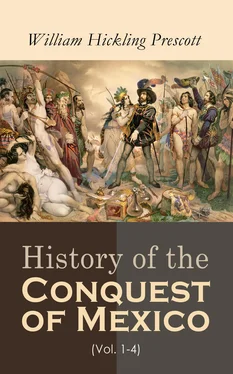Another writer whose works must be diligently consulted by every student of Mexican antiquities is Antonio Gama. His life contains as few incidents as those of most scholars. He was born at Mexico, in 1735, of a respectable family, and was bred to the law. He early showed a preference for mathematical studies, conscious that in this career lay his strength. In 1771 he communicated his observations on the eclipse of that year to the French astronomer M. de Lalande, who published them in Paris, with high commendations of the author. Gama’s increasing reputation attracted the attention of government; and he was employed by it in various scientific labors of importance. His great passion, however, was the study of Indian antiquities. He made himself acquainted with the history of the native races, their traditions, their languages, and, as far as possible, their hieroglyphics. He had an opportunity of showing the fruits of this preparatory training, and his skill as an antiquary, on the discovery of the great calendar stone, in 1790. He produced a masterly treatise on this, and another Aztec monument, explaining the objects to which they were devoted, and pouring a flood of light on the astronomical science of the aborigines, their mythology, and their astrological system. He afterwards continued his investigations in the same path, and wrote treatises on the dial, hieroglyphics, and arithmetic of the Indians. These, however, were not given to the world till a few years since, when they were published, together with a reprint of the former work, under the auspices of the industrious Bustamante. Gama died in 1802, leaving behind him a reputation for great worth in private life,—one in which the bigotry that seems to enter too frequently into the character of the Spanish-Mexican was tempered by the liberal feelings of a man of science. His reputation as a writer stands high for patient acquisition, accuracy, and acuteness. His conclusions are neither warped by the love of theory so common in the philosopher, nor by the easy credulity so natural to the antiquary. He feels his way with the caution of a mathematician, whose steps are demonstrations. M. de Humboldt was largely indebted to his first work, as he has emphatically acknowledged. But, notwithstanding the eulogiums of this popular writer, and his own merits, Gama’s treatises are rarely met with out of New Spain, and his name can hardly be said to have a transatlantic reputation.
Table of Contents
AZTEC AGRICULTURE—MECHANICAL ARTS—MERCHANTS—DOMESTIC MANNERS
IT is hardly possible that a nation so far advanced as the Aztecs in mathematical science should not have made considerable progress in the mechanical arts, which are so nearly connected with it. Indeed, intellectual progress of any kind implies a degree of refinement that requires a certain cultivation of both useful and elegant art. The savage wandering through the wide forest, without shelter for his head or raiment for his back, knows no other wants than those of animal appetites, and, when they are satisfied, seems to himself to have answered the only ends of existence. But man, in society, feels numerous desires, and artificial tastes spring up, accommodated to the various relations in which he is placed, and perpetually stimulating his invention to devise new expedients to gratify them.
There is a wide difference in the mechanical skill of different nations; but the difference is still greater in the inventive power which directs this skill and makes it available. Some nations seem to have no power beyond that of imitation, or, if they possess invention, have it in so low a degree that they are constantly repeating the same idea, without a shadow of alteration or improvement; as the bird builds precisely the same kind of nest which those of its own species built at the beginning of the world. Such, for example, are the Chinese, who have probably been familiar for ages with the germs of some discoveries, [210]of little practical benefit to themselves, but which, under the influence of European genius, have reached a degree of excellence that has wrought an important change in the constitution of society.
Far from looking back and forming itself slavishly on the past, it is characteristic of the European intellect to be ever on the advance. Old discoveries become the basis of new ones. It passes onward from truth to truth, connecting the whole by a succession of links, as it were, into the great chain of science which is to encircle and bind together the universe. The light of learning is shed over the labors of art. New avenues are opened for the communication both of person and of thought. New facilities are devised for subsistence. Personal comforts, of every kind, are inconceivably multiplied, and brought within the reach of the poorest. Secure of these, the thoughts travel into a nobler region than that of the senses; and the appliances of art are made to minister to the demands of an elegant taste and a higher moral culture.
The same enlightened spirit, applied to agriculture, raises it from a mere mechanical drudgery, or the barren formula of traditional precepts, to the dignity of a science. As the composition of the earth is analyzed, man learns the capacity of the soil that he cultivates; and, as his empire is gradually extended over the elements of nature, he gains the power to stimulate her to her most bountiful and various production. It is with satisfaction that we can turn to the land of our fathers, as the one in which the experiment has been conducted on the broadest scale and attended with results that the world has never before witnessed. With equal truth, we may point to the Anglo-Saxon race in both hemispheres, as that whose enterprising genius has contributed most essentially to the great interests of humanity, by the application of science to the useful arts.
Husbandry, to a very limited extent, indeed, was practised by most of the rude tribes of North America. Wherever a natural opening in the forest, or a rich strip of interval , met their eyes, or a green slope was found along the rivers, they planted it with beans and Indian corn. [211]The cultivation was slovenly in the extreme, and could not secure the improvident natives from the frequent recurrence of desolating famines. Still, that they tilled the soil at all was a peculiarity which honorably distinguished them from other tribes of hunters, and raised them one degree higher in the scale of civilization.
Agriculture in Mexico was in the same advanced state as the other arts of social life. In few countries, indeed, has it been more respected. It was closely interwoven with the civil and religious institutions of the nation. There were peculiar deities to preside over it; the names of the months and of the religious festivals had more or less reference to it. The public taxes, as we have seen, were often paid in agricultural produce. All except the soldiers and great nobles, even the inhabitants of the cities, cultivated the soil. The work was chiefly done by the men; the women scattering the seed, husking the corn, and taking part only in the lighter labors of the field. [212]In this they presented an honorable contrast to the other tribes of the continent, who imposed the burden of agriculture, severe as it is in the North, on their women. [213]Indeed, the sex was as tenderly regarded by the Aztecs in this matter, as it is, in most parts of Europe, at the present day.
There was no want of judgment in the management of their ground. When somewhat exhausted, it was permitted to recover by lying fallow. Its extreme dryness was relieved by canals, with which the land was partially irrigated; and the same end was promoted by severe penalties against the destruction of the woods, with which the country, as already noticed, was well covered before the Conquest. Lastly, they provided for their harvests ample granaries, which were admitted by the Conquerors to be of admirable construction. In this provision we see the forecast of civilized man. [214]
Читать дальше












